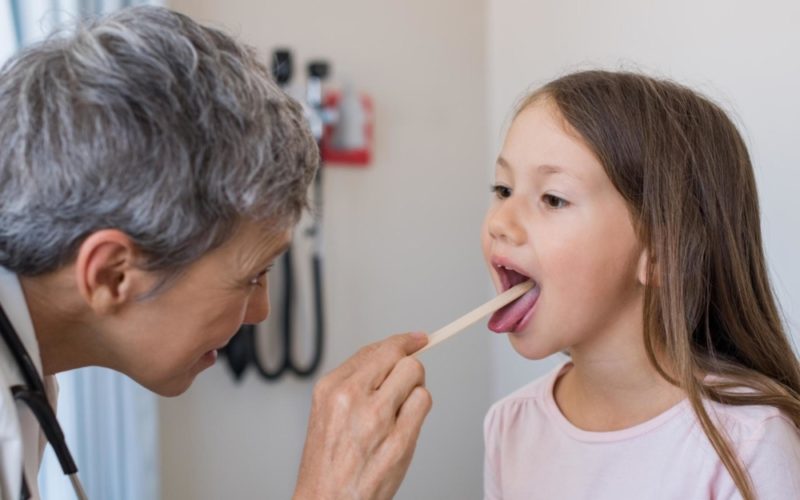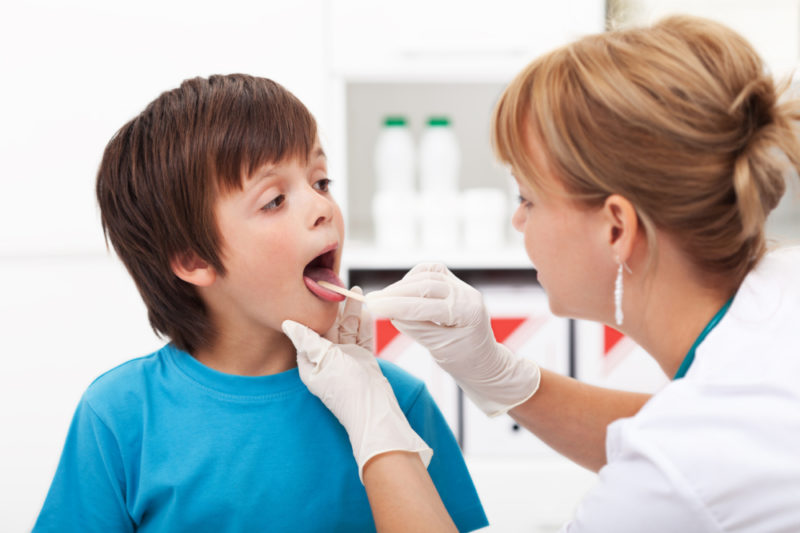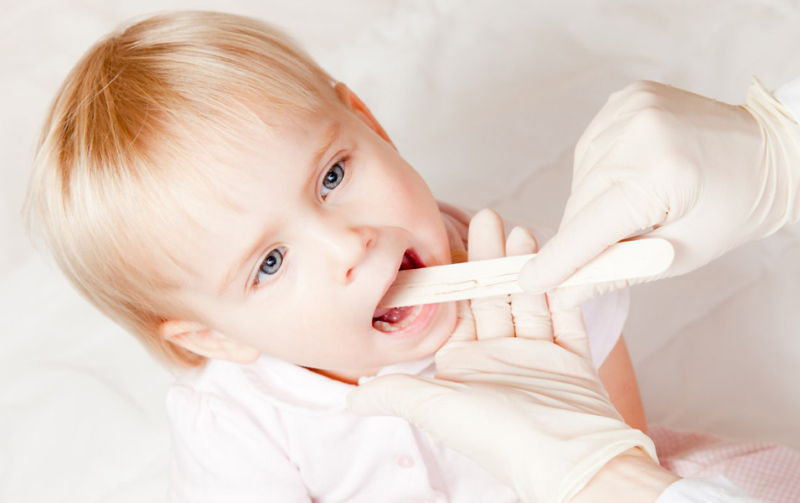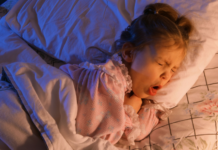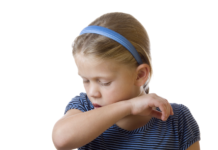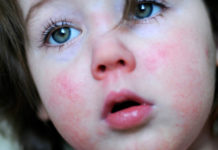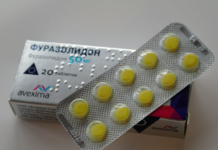Angina in babies is much more common than in adults. The fault is still not fully formed immunity of the child. The disease is manifested by severe symptoms, body temperature is poorly confused, therapy is not effective without antibiotics. To ensure an adequate approach to therapy, each parent should know the principles of treatment for tonsillitis in children and the symptoms of this very unpleasant disease.
Material Content:
- 1 What is angina, especially the course of children
- 2 Types of disease
- 3 Causes
- 4 Symptoms and signs of the disease
- 5 Diagnostic measures
- 6 Effective treatments for tonsillitis
- 7 Features of treating a child under 3 years old
- 8 Nutrition recommendations
- 9 Possible complications for the child's body
- 10 Preventive actions
What is angina, especially the course of children
Sore throat is an inflammation of the throat with typical symptoms of manifestation. It is often caused by streptococcus.
Angina is characterized by an acute onset. Microbes affect the tonsils - one of the organs of the lymphatic system.
Infectious disease has a number of features:
- It proceeds without consequences if treatment is prescribed on time;
- untreated infection leads to disruption of the heart, kidneys, bones (streptococcus rapidly affects these organs).
If a child complains of pain in the tonsils, then it is very easy to determine his sore throat. A distinctive feature is a white coating on the inflamed tonsils.
Concomitant symptoms:
- lack of a runny nose;
- temperature rise;
- red, painful, and swollen throat.
For "home" confirmation of the diagnosis, invite the child to eat an apple. After biting, he will not be able to swallow it due to acute pain in the tonsils.
Types of disease
It is a mistake to assume that a person has only two tonsils.
Six tonsillomas are known located in the nasopharyngeal region, forming a single lymphatic protective ring:
- palatine - 1 and 2 tonsils;
- pharyngeal - 3:
- lingual - 4;
- pipe - 5 and 6.
Most often, tonsils are subject to infection (a shift to the left occurs in the blood according to the leukocyte formula).
The causative agents are bacteria - staphylococci, streptococci, spirochetes.
Depending on the microorganism, on the place affected by it, and the severity of the course, it is customary to divide the sore throat into types.
Vulgar (normal):
- Catarrhal. Lightweight sore throat, proceeds superficially. Streptococcus causes sharp pain when swallowing. Tonsils enlarged, there is a small white mucous membrane. Temperature - from 38 ° С. A plaque forms in the tongue. Immunity is developed on the 3rd day, after which the infected person is no longer contagious.
- Follicular (purulent tonsillitis). Almond follicles become inflamed. Severe headache, temperature up to 39 ° C, pain when swallowing with the return of “arrow-shaped” pulses in the ear, back pain, fever is possible. Follicles are covered with pus. In children, not only vomiting is opened, but also diarrhea.
- Lacunar angina. The inflammatory process occurs in the tonsils, more precisely in their depressions (gaps). There is a whitish with yellow coating (purulent plugs). It is more complicated than the second subspecies of angina. Traffic jams spread over the entire surface area of the tonsils. Passes with timely treatment after 7 days.
- Fibrous Severe manifestation of the disease. It manifests itself as a continuous coating of purulent film. Sometimes it is a consequence of untreated lacunar tonsillitis. Severe fever, chills, and intoxication can cause brain damage.
- Phlegmonous. One of the tonsils is affected. She is covered with pus. Inflammation of the lymph nodes on the one hand, swelling is characteristic. Pain during conversation, temperature up to 40 ° С.
Herpes sore throat. It is characterized by the formation of specific vesicles on the tonsils. Severe pain during swallowing. Temperature up to 40 ° С. The causative agent is the herpes virus, Coxsackie. After 4 days, the bubbles burst. The disease goes away.
Ulcer-film. The causative agent is spirochete. The patient feels a foreign body, one tonsil becomes inflamed. From the mouth of those around you can smell rot, salivation is increased. It takes a long time, from 3 weeks.
Causes
You can get angina directly from the source of infection in one of the ways:
- airborne - through sneezing, coughing;
- enteral - eating dairy products infected with sore throats;
- hematogenous - through contact with infected blood;
- endogenous - pathogenic microorganisms multiply against a background of chronic inflammation: tonsillitis, caries, purulent sinusitis;
- artificial route of transmission of pathogens during surgical intervention on the nasopharynx, the patient receives the so-called traumatic tonsillitis.
Weakened immunity is a provoking factor in tonsil inflammation. In children, as a rule, it has not yet been formed, so getting a sore throat is much easier for a baby than an adult.
A child cannot get a sore throat if he drank a glass of cold milk or wet his feet. The causative agent is precisely the pathogen that creates inflammation on the walls of the tonsils.
Symptoms and signs of the disease
The manifestation of angina is due to general symptoms that are characteristic only for this infectious disease. Lack of a runny nose is the most important factor for diagnosing a sore throat. If there is an acute sore throat, but at the same time a person sniffs or breathing through the nose is limited, acute tonsillitis is not discussed. These are clear signs of acute respiratory infections, which, however, can lead to complications in the form of tonsillitis.
Typical symptoms of angina:
- acute sore throat when swallowing, talking;
- enlarged tonsils;
- dry mouth;
- plaque on the tongue and tonsils (mucus or pus);
- increase in body temperature to 38 - 40 ° C;
- general weakness;
- fever;
- chills;
- abdominal pain, vomiting, diarrhea (rarely);
- pain in the ears;
- headache;
- enlarged lymph nodes;
- bad breath;
- refusal of food;
- muscle aches.
Diagnostic measures
Red throat, swelling of the tonsils and lymph nodes, plaque, fever - these are the symptoms by which the doctor can diagnose a sore throat. The main examination method is pharyngoscopy (throat examination) In addition, other studies can be performed, for example, cultural and bacterial (mucosal inoculation).
In private clinics, a general blood and urine test is prescribed, which will help to eliminate the likelihood of complications at the final stage of treatment.
After recovery, the doctor again gives direction to a laboratory test. If abnormalities are found, it is recommended to visit specialists with a narrow profile.
Effective treatments for tonsillitis
It is only necessary to treat angina in a child only with an antibiotic from the penicillin group, and not otherwise. There is no other way to cure acute inflammation of the tonsils. Many believe that the use of pinicillin in the treatment of childhood diseases is the last century and they buy expensive drugs. But no matter how much money is spent on medicines, there is simply no way to find a more effective medicine.
Antibiotics for angina help to avoid complications, do not hope that the infection will go away on its own.
Drinking plenty of drinks has not been canceled. Drinking is based on the principle: the more often, the better. When fluid is swallowed, tonsils are cleansed of mucus and microparasites, which contributes to a quick recovery.
With a disease, the patient loses his appetite in the early days. The body begins to fight the infection. He is now not up to digesting food. You should not force a child to shout at him if he refuses a serving of soup or porridge. When the baby gets better, he himself will show interest in food.
Local rinsing, resorption of tablets have the same effect as frequent drinking in small sips.
For rinsing, you can use solutions prepared at home:
- in 1 liter of boiled water dissolve 1 tsp. soda, rinse every 30 min .;
- per 0.5 l of water - 1 tsp. soda, 1 hour. l salt, 10 drops of iodine, complete the procedure every hour.
You can not bring down the temperature if the thermometer shows less than 38.5 ° C. Immunity at this stage is fighting the infection. If the temperature begins to increase, it is worth using antipyretic drugs, for example, Nurofen or Ibuprofen. Antihistamines can be prescribed for children prone to allergic reactions.
Antimicrobial sprays, for example, Tantum Verde, Orasept, contribute to anesthesia of the throat, its quick recovery. Alternation of the spray with absorbable topical preparations - Strepsils, Faringosept, will help you to get to your feet faster.
Features of treating a child under 3 years old
What is the peculiarity of the treatment of angina in children under 3 years old? To understand the intricacies of this issue, you should initially learn about how tonsils develop.
Despite the fact that at birth and during the first year of life, the child does not have tonsils, the process of laying them occurs at the embryonic stage of development. Only after reaching the age of one year, the baby begins the process of enhanced growth of the lymphoid circular ring in the nasopharynx. Based on this, tonsillitis cannot be observed in children under one year old.
The complete formation of tonsils in a child falls in age from 1 to 2 years. Only after two years of life, the baby can get a typical tonsillitis. It is treated directly with antimicrobial agents (antibiotic from a number of penicillins, modern analogs - Augmentin 200, Zinnat).
Nutrition recommendations
The infected body needs a sparing diet. Do not force-feed your children if they have no appetite. At the same time, it is recommended to exclude foods containing strong allergens.It is also necessary to exclude from the diet acidic, spicy, too sweet, as well as solid foods that injure the mucous membrane. It is forbidden to give crackers, nuts, seeds. Drinking should be warm, in no case hot.
When drawing up the menu, it is worth giving preference to such products:
- honey (in small quantities);
- fruits;
- yogurts and other dairy products;
- oatmeal, semolina;
- vegetable purees.
- ground meat;
- soups, broths;
- heavy drinking (tea, water without gas, warm milk).
Possible complications for the child's body
The severity of the sore throat, the timely and correctly prescribed treatment depends on the presence of complications in the child.
The most common pathologies after bacterial inflammation of the tonsils are:
- rheumatism;
- glomerulonephritis;
- heart failure;
- otitis media, sinusitis;
- bronchitis, pneumonia;
- meningitis;
- chronic form of tonsillitis.
Preventive actions
Strong immunity is the prevention of all infectious diseases. The protective function of the body in the first years of life is formed gradually, it is the strongest with minimal contact with bacteria.
Exceptional cleanliness in the house is not a positive factor for the formation of strong immunity. The main emphasis should be on the nursery. It should always be fresh (temperature not higher than 23 ° C), the air is humidified (50 - 60%).
Prevention measures include:
- constant hardening;
- balanced diet;
- physical activity;
- walks in the fresh air for at least 1.5 hours
Strong immunity is the key to the health of the child, do not forget about it.


